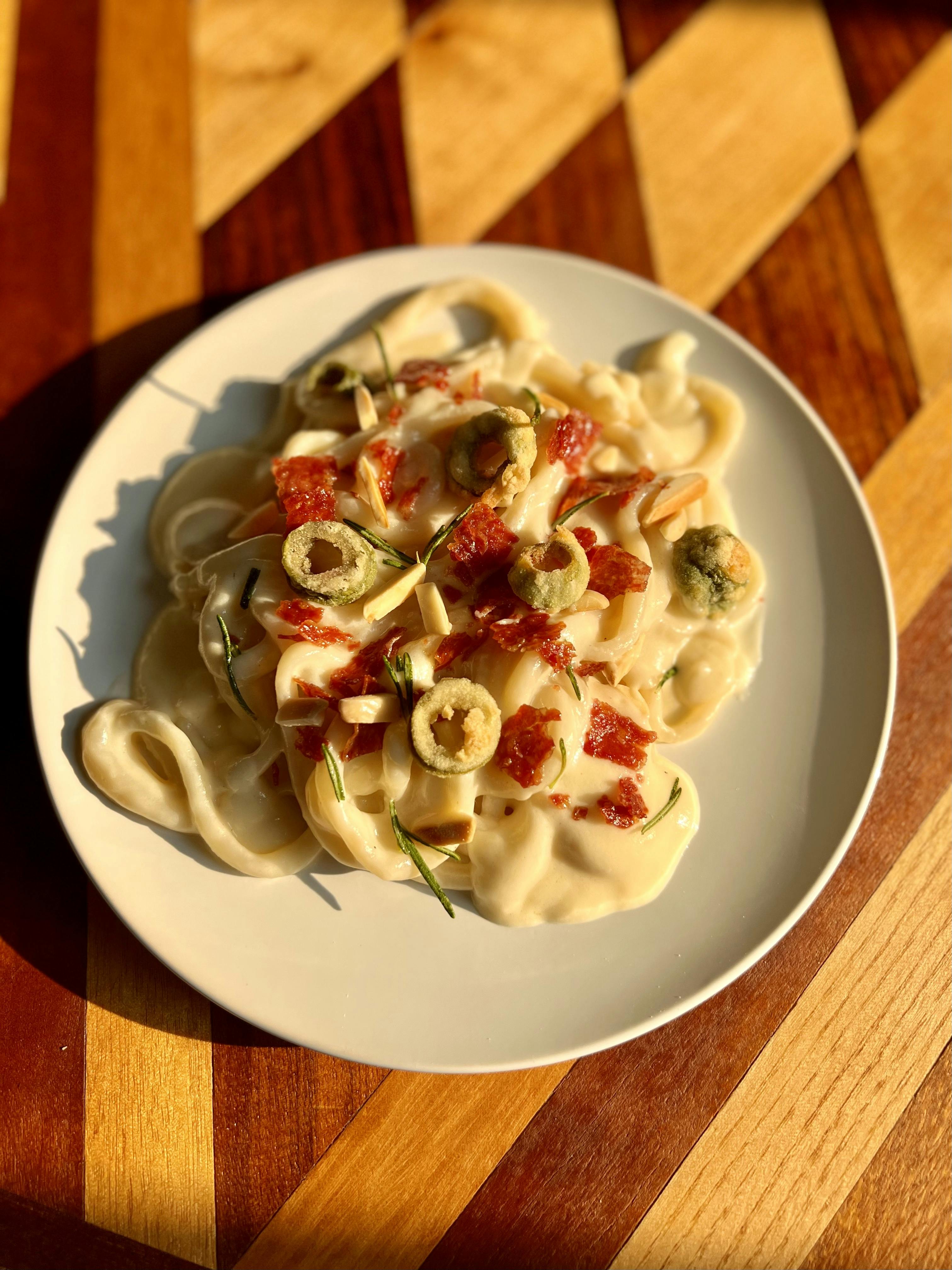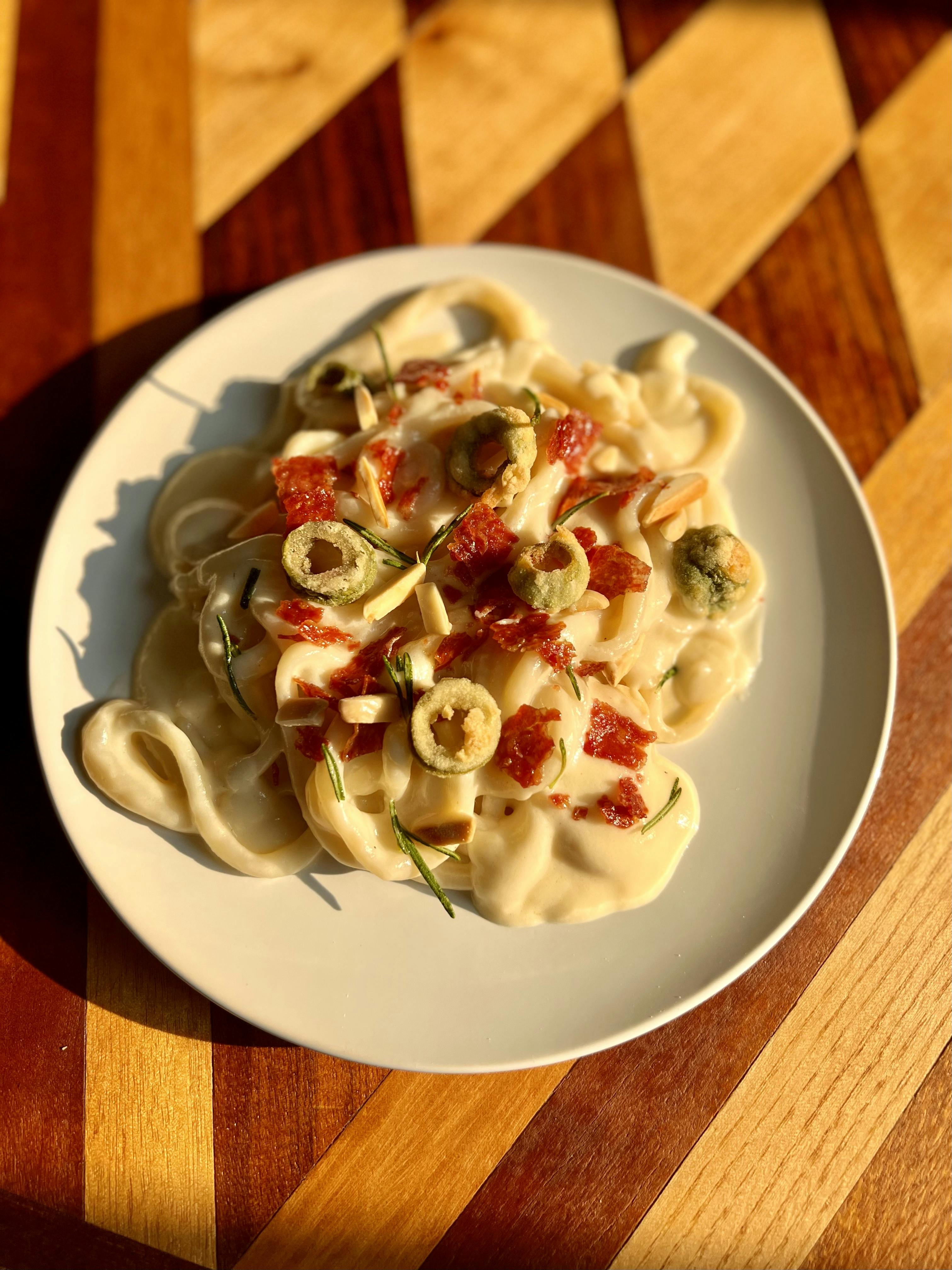by Jon Bennion
If you go to a gathering at someone’s home or an office party, there is a good chance you will see a charcuterie board. They usually have a diverse selection of little nibbles for people who are enjoying drinks and conversation. These trays of cured meats, cheeses, nuts, dried and fresh fruit, crackers, olives, spreads, and other items seem to have something everyone likes.
Charcuterie boards are so popular that I decided to blend many of these same ingredients into a homemade pasta dish that anyone can make at home without special tools. ANYONE! It takes elements of a regular board and pairs them with a hand-rolled Tuscan pasta called “pici” (pronounced “peachy”) and the insanely delicious Double Cream Gouda from Artikaas. This creamy, flavorful combo is one that takes charcuterie boards into main course territory.
Pici is a great homemade pasta for anyone without a lot of pasta-making experience. You probably have all of the ingredients in your home right now – flour, water, salt, and olive oil. No, it doesn’t have eggs, which is typical for several different kinds of pasta from Italy. The hand-rolling part means you don’t even need a pasta machine.
The pici is a wonderful noodle to be the vehicle for all the flavor I built into the dish. I used an Artikaas Double Cream Gouda because it has amazing flavor, melts very well for the sauce, and could easily be a cheese you’d find on any top-notch charcuterie board. A Genoa salami was my choice for the charcuterie, but you can use any kind of thinly sliced charcuterie you’d like. Fried olives provide a bit of brine, and toasted slivered almonds bring the crunch. A bit of herbaceous rosemary flavor is infused in the sauce and doubles as a topping once crisped.
If you have friends that love a good charcuterie board, they will love this pasta dish. But be warned: making your own pasta can become a culinary obsession!
CHARCUTERIE BOARD PASTA:
- 3 cups all-purpose flour
- 1 1/3 cup warm water
- 1 tbsp olive oil
- ½ tsp kosher salt
- 8 -10 pieces of salami
- 3 tbsp butter
- 3 tbsp all-purpose flour, plus 1 cup for olives
- 3 cups whole or 2% milk, plus 1 cup for olives
- 6 oz Artikaas Double Cream Gouda
- 1 long sprig of fresh rosemary
- 10 jumbo castelvetrano olives
- 1/3 cup slivered almonds
- Pinch of freshly ground nutmeg
- Olive oil
Serves 4-5 people

Pile the flour on your counter or in a mixing bowl. With the bottom of a cup, create a deep well in the center. Pour in the warm water, olive oil and salt and let it sit for a minute as the flour and water start to interact.
If you are kneading on the counter, bring tiny bits of flour from the inside of the rim into the water and mix gently. Keep doing this until the liquid center becomes thicker and won’t spill. Bring larger amounts of the flour into the center, and cut it into the wetter portions. At this point, use your hands to grab all the contents and start smashing and pressing them together until it forms a shaggy dough ball. If you are using a mixer, use a dough hook attachment and mix until all of the ingredients are incorporated.
The pici dough needs a 10 minute knead, which I always do by hand. Using your upper body strength, press down, stretch, refold, and turn your dough. Early on, it will look like a mess with a lot of bumps and irregularities, but keep going for the full ten minutes. Put it in plastic wrap or in a sealed plastic bag to rest for a minimum of 30 minutes, or up to two hours.
Remove the dough and place on your counter. With a rolling pin or your hands, thin the dough until it’s about ¼ inch thick and in a rectangle shape. From here, you can place a damp paper towel over the top so the dough does not dry out. The hand rolling works best on a large wooden cutting board. If you don’t have that, just roll them out on your counter.
To roll out the pici, cut a 1/8” section of the dough across the short side of the dough rectangle. Place on the cutting board or other surface and start rolling with both hands from the center on to the ends. The final noodles should be smaller in circumference than a pencil, and keep in mind they will plump up some when cooked. Place finished pici on a parchment-lined baking tray with a bit of flour to prevent sticking.
Slice your olives into ¼” pieces. Toss them in 1 cup of flour, getting them covered well. Take them out of the flour and put them into 1 cup of milk. Return them to the flour and let them sit in the flour until they are ready to fry.
In a very large frying pan preheated to medium, toast your slivered almonds for about 2-3 minutes, stirring occasionally until there is a bit of golden brown on some of the sides. Remove from pan and set aside until the end. In the same pan, sauté your salami for 7-8 minutes until it starts to get crispy. Remove the salami onto a plate with a paper towel and save until the end. Leave any fat from the salami.
In the same pan, melt your 3 tablespoons of butter and add the rosemary, turning it occasionally so all of the sides of the rosemary get direct heat in the butter. Once you see a bit of the rosemary browning, set aside until the end. Add 3 tablespoons of flour and mix with the butter. Cook for 2-3 minutes, stirring occasionally.
Whisk in 3 cups of room temperature milk and get out any lumps. Freshly grate a healthy pinch of nutmeg into the sauce and allow it to come to a simmer. Grate your Artikaas Double Cream cheese while you wait. Once simmering, drop the heat to low and stir in your cheese.
In a small frying pan on medium heat, place enough olive oil to come up 1/8” inch high. Remove your olives from the flour. In batches, fry your olives until golden brown on both sides. Once done, remove them onto a plate with a paper towel.
Cook your pici in a large pot of boiling, salted water. They only take 2-3 minutes to cook. If your frying pan with the sauce is large enough to take all of the pici, you can pull the pici from the water and put it directly into the pan to stir to incorporate. Otherwise, drain your pici and put back into the pot it cooked in, then add the sauce, stirring gently to get the sauce all over the pici.
For plating, top the cheesy pici with broken pieces of crispy salami, some leaves of crispy rosemary, fried olives, and slivered almonds.
